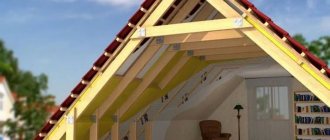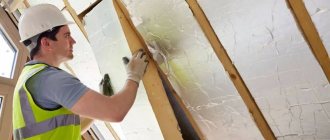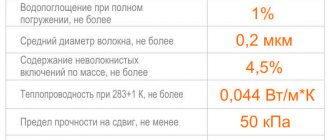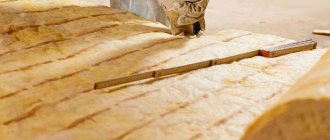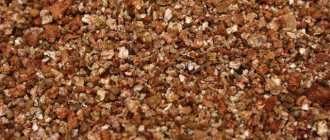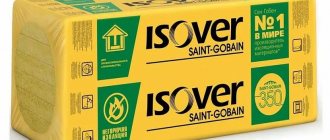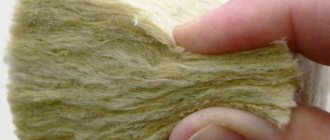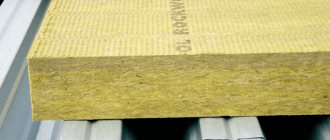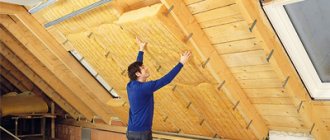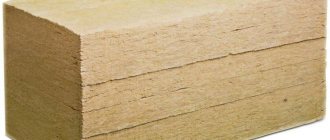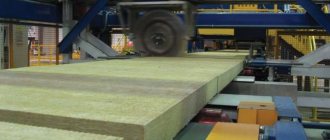The topic of today's article is the density of roof insulation. The topic is relevant because the thermal characteristics of the roof itself depend on the density of the thermal insulation material. And the higher the density, the higher the thermal conductivity of the thermal insulation layer, as well as its price. Therefore, it is important to choose the right insulation. This will be discussed in the article using mineral wool as an example.
Density of mineral wool of different versions Source fasadec.ru
Mineral wool for roofing - which one to choose
Mineral wool is traditionally considered the best insulation for pitched roofs, creating a thermal insulation layer above the attic. Experts recommend this material for roof insulation. Let's figure out why this happens, because polystyrene foam is cheaper. Also, mineral wool varies greatly in its properties - which one is better suited for the roof truss system?
What is the difference between mineral wool - expert opinions
If you listen to the opinions of experts, it is not difficult to notice that mineral wool is best combined with wooden structures. It allows steam to pass through itself well, and the wood in contact with it does not become damp.
But this property requires the arrangement of steam regulation of the insulation layer - a vapor barrier on the room side, and ventilation on the street side, free movement of outside air through the vent. gap.
Mineral wool is resistant to fire and does not ignite, so it may not be separated from living rooms by fireproof shells. But at the same time, it is not environmentally friendly, so the vapor barrier and interior decoration also perform a protective function.
Various quality and characteristics
Mineral wool can vary greatly in physical characteristics, from heavy, durable (non-compressible) slabs to rolled soft material.
In this case, the specific gravity can be from 30 kg/m3 to 200 kg/m3. Fibers can be made from various minerals. Manufacturers often use cheap waste from large-scale industries in the form of slag. But basalt or quartz sand can be used...
- The fibers themselves can be long, large, form pliable mats, rolled materials, then the material is usually given the name glass wool.
- If the fiber is thin, brittle, dusty, and the slabs themselves are hard and fragile, then the insulation is more often called “rock wool”.
But what to choose for the roof?
Thermal conductivity and layer thickness
If you read the advertisement, you can learn from it about the excellent properties of mineral wool; sometimes an extremely low thermal conductivity coefficient is indicated, for example, 0.027 W/m*K, almost like air. In reality, due to moisture, the working value is much higher. For heavy dense samples, at least 0.05 W/m*K should be taken for calculations. For soft ones for the initial period of operation - 0.045 W/m*K, but later after shrinkage this coefficient increases.
In accordance with this, it is not difficult to calculate the thickness of the layer, guided by regulatory data on the resistance of structures to heat transfer. For a roof located somewhere in central Russia, where this value is about 4.5 m2 x °C/W, a mineral wool thickness of at least 20 cm will be required.
Mineral wool options
Meeting application technologies, and therefore consumer needs, manufacturers create mineral wool samples with special properties and new characteristics.
- Foil plates. Many people do not recommend using foil in the roof or shielding a house with metal. The existing natural electromagnetic background should not be disturbed. There is no need to interfere with the operation of radio devices.
- Plates with vapor barrier film. In principle, it is not bad to have an additional vapor barrier on each slab, but this will not negate the use of a solid membrane over the entire area of the insulating layer.
- Layers of different densities. The top layer of increased density (more than 80 kg/m3) is not ventilated under normal conditions in the ventilated façade system, while the main layer is lighter and heat-insulating. This option is the most preferable in many cases.
- Coating with superdiffusion film An option in which mineral wool is immediately supplied with vapor-permeable protection against blowing has its place, but is usually expensive...
Service life is the most important characteristic
Less dense slabs from unknown manufacturers quickly shrink, the layer shrinks, and the thermal insulation properties decrease down to 50-80% of the calculated ones. Over what period will this happen...
Well-known manufacturers indicate the expected service life of their mineral wool - up to 50 years. These figures refer to dense (elastic) samples that retain their shape and restore it when compressed. But the stated period has not been proven in practice and is not officially confirmed by government research.
Leaky and cheap samples, as a rule, are not standardized at all. Their lifespan will largely depend on the position in the structure and on the initial loads that determine the compressive forces.
Which mineral wool should not be used for roofing
The roof insulation technology involves placing mineral wool between the rafters. It is extremely important that there are no gaps or voids left - the insulation boards should be inserted sideways, with some pressure from the sides.
Also the most important indicator is the total mass, i.e. the specific gravity cannot be too large, the additional material should not create a significant load on the roof structures. But exact figures can only be determined in each specific case.
Accordingly, rigid and heavy samples are not suitable for roofing. As a rule, over 100 kg/m3 are not applicable in these cases.
What can be applied
But too soft, caking mineral wool samples are also not the best choice. Heat loss through the roof is usually the greatest. Therefore, the standards require that insulation of the greatest thickness be installed in this place, compared to other structures. Failure of insulation over such a large and important area will have a very significant impact on the overall energy losses of the house.
Therefore, experts recommend using special samples of mineral roofing designed for pitched roofs of private houses, and only from well-known manufacturers. The recommended density starts from 60 kg/m3.
Which manufacturers have been on the market for a long time?
Mineral fibers are created in large high-tech industries. The products are then supplied to companies that directly manufacture slabs from them for insulation of private houses. There, the fibers are glued together with a binder and formaldehyde (usually), compacted to the required values, etc.
Well-known brands under which mineral wool for roofs is sold:
- Knauf. The most famous brand in Russia and Europe selling mineral wool insulation. The technology for manufacturing fiberglass material has been given its own name, ECOSE Technology. The manufacturer claims that the products meet European quality standards.
- Ursa. Well-known samples have earned trust as elastic mats that restore their shape. They claim fiberglass of the highest quality; in some insulation options, the fibers are bonded together without the use of formaldehyde...
- Izover. Also a well-known brand in Russia, Ukraine, and the CIS, which has been distributing its products for quite a long time and very successfully, it has earned respect. It is also announced that mineral fibers will be created using a special technology, this time the secret meaning is contained in the abbreviation - TEL.
Comparative characteristics of foam concrete and other building materials
| Options | Ceramic brick | Ceramic block | Silicate brick | Gas block | Foam block |
| Dimensions, cm | 25/12/6,5 | 38/25/24 | 25/12/6,5 | 20/30/60 | 20/30/60 |
| Wall weight, kg/m2 | 1200 — 1800 | 600 — 800 | 1450 — 2000 | 100- 900 | 100 — 900 |
| Density, kg/m 3 | 1500 — 1750 | 700 — 900 | 1700 — 1950 | 300 — 1200 | 300 — 1200 |
| Water absorption,% | 12 | 12 — 14 | 16 | 20 | 14 |
| Thermal conductivity, W/M*k | 0,4 — 0,7 | 0,1 — 0,2 | 0,8 — 1,1 | 0,1 — 0,4 | 0,1 — 0,4 |
| Frost resistance, cycle | 25 | 50 | 25 | 35 | 35 |
| Ultimate compressive strength, MPa | 2,5 — 25 | — | 5 — 30 | 0,5 — 25 | 0,25 — 12,5 |
| Consumption, pcs./m 3 | 400 — 500 | 34 — 45 | 400 — 500 | 21 — 27 | 21 — 27 |
| Price, $/m 3 | 63 — 112 | 62 — 90 | 17 — 90 | 60 — 94 | 49 — 68 |
- What is the difference between aerated concrete or foam concrete - comparison of advantages and disadvantages
About the use of insulation
The general category of insulation, obtained by dividing the raw material into fibers, is usually called mineral wool.
The widespread use of inorganic insulators is associated with high heat and sound insulation properties:
- construction of engineering communications;
- to protect industrial equipment;
- in the field of construction.
Insulation of the roof of a building
The main advantages of mineral wool:
- There are completely no organic elements in the structure of the product, which allows the service life to be unlimited;
- does not burn - class NG, NPB 244-97;
- the material belongs to breathable insulation - the fibrous structure allows excess moisture vapor to pass through, air circulation is maintained;
- does not decompose or mold;
- does not attract insects and rodents;
- tolerates temperature fluctuations and exposure to aggressive environments.
Mineral wool is used in interior decoration in accordance with building codes (SNiP) and codes of practice. The vapor permeability of the material is especially important for insulation and sound insulation of wooden and stone structures. High performance properties of the best types of mineral wool and reasonable price are the main factors for consumer choice.
Signs of a “correct” pitched roof
High-quality materials, coupled with compliance with insulation technology, guarantee a long service life of the roof without “crying” walls in the attic, mold and mildew. A properly insulated pitched roof provides a comfortable microclimate in the attic without the need to increase the power of the boiler in winter or the air conditioner in summer. You can technically verify the effectiveness of roof insulation by examining it with a thermal imager. The device will show the absence or presence of zones through which owners “drown” the street. But even without equipment in winter, the main sign of mistakes made can be seen with the naked eye - “garlands” of icicles. On a roof where the insulation is done correctly, the snow lies in a uniform mass, without melting, and there is nowhere for icicles to come from.
Main types
The source material and manufacturing technology determine the future characteristics of the product and the type of mineral wool. Main groups by type of raw material:
- stone (basalt);
- slag (slag wool);
- fiberglass (glass wool).
Basalt mineral wool
The raw material for the manufacture of insulation is volcanic rock (basalt) or dolomite. The hardness and fine-grained nature of the material make it possible to produce super-thin (1-3 microns) fibers up to 5 cm long in the mineral wool structure. Due to the small number of ingredients, simple manufacturing technologies are used. The thermal conductivity of stone wool is the lowest among the main types of insulation.
Basalt fiber insulation
The advantages of this type are manifested in the following characteristics:
- compressive rigidity of the material - installation of vertical insulation sheets does not require supporting supports;
- chemical resistance;
- durability (service life up to 50 years);
- low hygroscopicity – optimal air humidity is maintained;
- high strength, elasticity;
- good sound absorption – high degree of sound insulation;
- fire resistance – up to 1000°C;
- environmental friendliness
Basalt wool can withstand loads when reinforcing and plastering the surface. Insulation sheets are placed inside the wall, as part of fire protection structures.
High performance qualities ensure the versatility of using basalt insulation.
Foiling stone wool enhances the thermal insulation properties of the product. When arranging the sheets, it is important to point the shiny surface towards the room.
Foil insulation
In operation, basalt mineral wool is more convenient in comparison with other types of insulation due to the fact that during production the fibers do not take on pointed shapes.
The disadvantages of the material include:
- dust formation during work - a mask or respirator is required;
- relatively high cost.
In practice, high demand in private construction for stone mineral wool remains due to the fact that:
- the quality of the slabs fully complies with the requirements for internal and external wall insulation;
- The labor intensity of the process is lower than when working with other types of mineral wool.
Slag wool
The raw material for the production of mineral wool is waste from the metallurgical industry - blast furnace slag. The cotton wool fibers obtained through processing are up to 16 mm in length, with a diameter of 4-12 microns - the smallest size due to the chemical composition and processing technology of raw materials.
Slag
The special properties of the material limit its use in private construction; insulation is more often used for thermal insulation of non-residential premises.
The advantages of slag wool include:
- Possibility of installation on round, shaped surfaces;
- high-quality sound insulation;
- fire resistance;
- durable operation - up to 50 years;
- high chemical and biological stability;
- low cost.
- low sintering and application temperatures;
- hygroscopicity – cannot be used for insulation of facades or water pipelines;
- exposure to temperature fluctuations - the quality of thermal insulation decreases;
- barbs during installation;
- the presence of phenol-formaldehyde resins, which are harmful to health;
- low vibration resistance - loads lead to subsidence of the material, increasing thermal conductivity;
- slag acidity – incompatibility with metals at high humidity.
The safe use of slag wool is recommended for insulating attics, basements, and non-residential buildings, since the material is inferior in quality and inconvenience to work to other types of insulation. Its use is wider at industrial facilities.
The products are characterized by the lowest rigidity (compression). The level of good thermal insulation is comparable to other types of mineral wool.
Glass wool
The production of fiberglass material is based on the use of up to 80% cullet and silicon rock as raw materials. The addition of sand, soda, limestone and other ingredients does not exceed 20%. The mixtures are melted and blown with centrifuges to obtain thin fibers approximately 5 cm long. The performance properties of the product are of a good level, but working with fiberglass material requires the use of protective equipment.
Installation of glass wool
The widespread use of glass wool, despite the large selection of alternative insulation materials, is based on certain advantages of the material:
- chemical resistance;
- insulation of uneven surface shapes;
- good sound absorption;
- vibration resistance;
- low thermal conductivity;
- fire safety;
- low price.
Significant disadvantages of the material are:
- high water absorption - vapor protection is needed;
- causticity;
- low heat resistance;
- the need for reliable insulation;
- service life up to 10 years, significantly shorter compared to other insulation materials.
Working with glass wool requires special care: enhanced protection of the organs of vision, respiratory tract, and skin.
The high fragility of the fibers carries the risk of particles getting into the lungs and mucous membranes, which causes severe irritation, swelling, and allergic reactions.
Working with glass wool
Types of mineral wool
Basalt mineral wool
The insulation, which is produced from igneous rocks, is reliable, easy to use and safe for humans. This sets it apart from other types of mineral wool.
Glass wool
The second most popular type of mineral wool. It is noticeably inferior to the first in safety and other technical characteristics. This material is made from the same raw materials as glass (quartz sand, soda and lime).
Slag wool
Mineral wool from blast furnace slag, a waste product from metallurgical production, is becoming a thing of the past. The demand for it is low, since slag wool contains phenol-formaldehyde resins, which are hazardous to health. Nowadays it is used only for external insulation of temporary buildings.
The best manufacturers
The comfort and safety of people in the room depends on the use of proper insulation. Leaders in the production of mineral wool strive to achieve a product combination of construction advantages, environmental friendliness of the product while maintaining an acceptable price for the product.
According to consumer reviews, the ranking of the best brands is as follows.
Danish company with factories in Russia. They produce stone wool with enhanced properties:
- fire safety - fibers can withstand temperatures up to 1000°C (standard 600°C);
- sound absorption – products are chosen for acoustic comfort;
- environmental friendliness;
- durability - maintains quality indicators during operation;
- thermal insulation.
In the production of basalt wool, the company identifies priority quality areas, which are:
- saving energy, including heat;
- environmental friendliness;
- soundproofing;
- fire safety.
The manufacturer does not allow counterfeits and realizes the advantages of stone wool in full.
The downside is the high price.
Facade insulation
The manufacturer produces two types of insulation: stone wool and fiberglass wool. This suits builders who need different materials according to the conditions of the objects being built. The best side of the product is the reduction in the “prickliness” of products while maintaining high characteristics of the main indicators.
The price-quality ratio of this company is one of the best on the mineral wool market.
Izover insulation
The products are represented by basalt mineral wool and fiberglass-based insulation.
An important factor was the specialized purpose of the products, reflected in the names:
- Acoustic partition;
- HEATWALL;
- WARM roofing, etc.
The environmentally friendly material is intended for construction work on the construction of residential buildings. The high price is the only drawback.
The low price of basalt products used for insulation of walls, facades, and roofs is attractive. Quality indicators meet standards. The disadvantage is a slight shedding of the material during work. A particularly popular area is finishing attics and pitched roofs with Izovol mineral wool. Mineral wool is fire resistant, environmentally friendly, and has good thermal insulation properties.
Insulation of internal walls and ceilings
The best mineral wool for insulation from the inside
The best solution for insulating ceilings and walls inside the house with mineral wool will again be material made from rocks. It is environmentally friendly, allows steam to pass through well, does not burn, does not attract rodents and does not become a breeding ground for living organisms.
Do not use mineral wool made from imperfect materials to insulate the walls of a house from the inside. Remember that slag wool is toxic, and fiberglass consists of extremely brittle and caustic particles that can become airborne with dust. When they get on the mucous membranes, they cause irritation and allergic reactions.
Don’t know what thickness or density of mineral wool is required for internal insulation? Focus on the following indicators: thickness - 2-10 cm, density - 15-20 kg/m³. A material whose characteristics are closer to the upper limits is optimal for insulating a balcony or loggia with mineral wool.
Mineral wool insulation technology
Internal insulation is not often used: this method “eats up” free space and does not cope with its tasks as effectively. However, if for some reason you decide to insulate from the inside, you can glue cotton wool or fix it on the sheathing, and then cover it with sheets of plasterboard.
Consumer choice
In private construction, approximately 80% of the purchased insulation is basalt and stone mineral wool, which have universal quality characteristics. Slag and fiberglass wool are used more often in enterprises for thermal insulation of specific objects.
Reliable thermal insulation
In practice, which mineral wool is best for insulation needs to be decided taking into account a specific building, room, structure. When making design decisions, specialists calculate in advance what density of mineral wool is best to choose and how to use the material correctly.
Errors most often occur not because of the quality of the insulation, but because of its improper use. It is recommended to carefully study information from the manufacturer about the characteristics and properties of mineral wool, and features of use.
Conclusion
In order for a pitched roof to fulfill its purpose and reliably protect the house not only from external influences, but also from increased operating costs due to heat loss, it must be well insulated. In this case, living in the attic will be as comfortable as possible without overpayments, and the need for major repairs will not arise soon.
About single-layer insulation - in the previous material. Owners of wooden houses will find the article about insulating a timber house with stone wool useful. The video shows how to choose and lay stone wool correctly.
Source
Principles for choosing roof insulation
On our website we have already devoted quite a few articles to the principles of choosing various thermal insulation materials. In this material we will look in detail at which insulation to choose for the roof and we will look at the choice of insulation specifically in this section. Here are a few things to consider about your roof.
- Roof enclosing structures have increased requirements for thermal resistance. For example, in 2010 in Finland, the coefficient of such resistance for walls was 5.88 m2*C/W, and for the roof it was 11.11! Almost double the difference.
- The material on the roof is more exposed to moisture than others. And, as you know, water is the enemy of thermal insulation.
- Roof insulation is installed, in fact, according to the principle of ventilated facades. This means that it is not protected from fire, for example, by concrete or plaster elements. In this regard, the insulation itself must have increased fire resistance.
- And it doesn’t matter whether we are talking about a flat or pitched roof, the insulation area is quite high, so the cost of the material should be reasonable and fit organically into the estimate for building or renovating a house.
These are the basic general requirements for thermal insulation for a roof. However, you need to take into account the type of roof. [flat_ab id=”33"]
Facade insulation
Which mineral wool to choose for insulating walls outside?
For insulating houses with mineral wool on the outside, a material based on basalt is suitable. Don't be afraid to use this mineral wool to insulate frame walls, aerated concrete and wooden structures. It has the least hygroscopicity, which means it will not absorb moisture that falls on the facade during precipitation.
The thickness of façade insulation with mineral wool ranges from 5 to 20 cm, depending on climatic conditions. The required density of mineral wool for insulation is 50–110 kg/m³ (for insulation of ventilated facades) or 130–150 kg/m³ (for insulation with mineral wool under plaster).
Mineral wool insulation technology
Types of roofing and insulation for them
When choosing a material for insulating the roof of a house, the difference between the three types of roofing structures is important:
- Flat roof;
- Pitched roof (cold attic);
- Mansard roof (floor).
Each of the three types of roofs requires its own approach in choosing insulating materials.
A flat roof is most often used, which means that the thermal insulation of the roof must be rigid. For these purposes, extruded polystyrene foam is most often used, for example, penoplex or rigid mineral wool insulation. Typically, each manufacturer has special solutions for this type of roofing. Slabs with cuts allow you to create the desired slope and special gutters for discharging water. It is enough to lay such a layer of insulation correctly and the roof can be considered insulated.
You can insulate a pitched roof with a cold attic along the floor. However, in some cases, insulation is also inserted between the rafters. For these purposes, soft and elastic mineral wool slabs are most often used, which are inserted into the spacer. The attic floor is insulated with various materials, both sheet, bulk and sprayed.
An attic roof is essentially the walls of a room, but they are made not of concrete or brick, but of rafters and, for example, tiles. This design is more expensive than a separate, ordinary floor. Roof insulation for an attic roof must be environmentally friendly, because, in essence, we are talking about insulating the room from the inside. There are also increased fire safety requirements. In a separate article, we examined in detail the issue of using polystyrene foam in insulated attic roofs. Most often, such roofs are insulated with mineral wool.
Insulation technology for pitched roofs
For the most part, when the attic floor is initially planned as a residential floor, insulation is carried out as follows.
When the insulation is installed before installing the waterproofing layer and roofing - the most risky, but also the most popular installation procedure in Russia.
Risky, because it is not always possible to install insulation and cover it with waterproofing in one day, and if the weather turns bad and it rains, both the rafters and the thermal insulation will get wet, which is unacceptable when insulating the roof; the thermal insulation must be dry. But even when insulating an already closed circuit, mistakes are often made. On the forum there is approximately an equal number of “What should I do?” questions asked after installing the roofing.
Help is needed. We have a country house with a 2-pitched roof (attic). On the roof (from outside to inside): corrugated metal sheet, roofing felt, sheathing, rafters. The fact that it is necessary to disassemble and make a counter-lattice is understandable, but the house is not for permanent residence, but rather a weekend cottage (spring, summer, autumn) and a couple of times in the winter, so I want to minimize costs. I need advice on what can be done to prevent the roof from rotting.
Today I see 2 options:
Mount bars between the rafters to create a ventilated gap, then install a windproof membrane with a snake, and lay insulation in the free space. On top of the entire structure, make a lathing with a vapor barrier and a final coating.
Colleagues have a question, I want to make an attic, the ceiling and rafters are 50x200 mm timber, sheathing and temporary roofing material have been made, I want to cover it with metal tiles and insulate it. How to properly insulate and do it wisely?
“Classical” technology for insulating a pitched roof - in a training video.
Is the most popular one suitable? - Styrofoam
It is worth mentioning that by foam plastic we mean both ordinary, white polystyrene foam (PSB-15) and extruded polystyrene foam, the density of which can reach 35-45 kg per cubic meter.
So, PSB-15 is not used for flat roofs. Although it is much cheaper, it can still be damaged when installing insulation by simply stepping on the sheet. In addition, the foam is made without a quarter. But, for example, penoplex has special grooves at the edges that are fastened together and create one indestructible layer of insulation on the plane.
The ceiling of a cold roof is often insulated with foam plastic in the frame when it is laid between the joists. For the same purposes, more moisture-resistant polystyrene foam is used, which, by the way, has much greater compressive strength.
The issue of using this material for a residential floor under the roof was discussed separately, and this is generally a whole topic.
Thermal insulation materials start with polystyrene foam. But, alas, it does not qualify for the title of best insulation for roofs. That's why they mentioned it at the very beginning. Further - more interesting. [f[flat_ab id=»34"]p>
Description of slabs with different density levels
There are basalt slabs of various density levels. This is reflected in the following properties of insulation: vapor permeability, moisture resistance, resistance to high loads and response to compression of the material.
Table of parameters of basalt insulation
Based on density, slabs are divided into the following categories:
- Up to 35 kg/m3 – used for vertical and inclined insulation without load.
- Up to 50 kg/m3 - with the help of such insulation they increase the level of thermal insulation of interior partitions, attics or attics. Where there is no load on the surface.
- Up to 75 kg/m3 – lightly loaded surfaces, under floors when placed between joists.
- Up to 100 kg/m3 – external insulation of industrial and residential buildings.
- Up to 125 kg/m3 – arrangement of ventilated facades.
- Up to 150 kg/m3 – single-layer insulation of reinforced concrete or metal building frames.
- Up to 175 kg/m3 – insulation of heavy buildings with further plastering of the facade. Or it is located inside a three-layer cake.
- Up to 200 kg/m3 - insulation with such a density can withstand the highest loads. The soundproofing qualities of the material are significantly higher than analogues with a lower density level.
Roofing classics - mineral wool
By mineral wool, people most often mean:
The latter is highly not recommended. The maximum where you can use insulation from waste from the metallurgical industry is not residential buildings of enterprises.
Stone wool is used for residential premises. Although it contains resins such as formaldehyde, their percentage is still insignificant, and moreover, it has undergone a polymerization process. This means that the resin has settled and is now in a solid state with a closed molecular structure.
For flat roofs, as already mentioned at the beginning, rigid mineral wool slabs with a density of 140-160 kg/m³ are used.
To insulate a pitched roof, soft slabs are inserted between the rafters, trimming them. The same slabs are inserted between the joists and covered with a protective coating on top in case of overlap. Mineral wool is most often used for roof insulation. This is due to its “breathable” structure. The fact is that any wooden structure must be well ventilated. And if polymer insulation is adjacent to it, this procedure becomes much more complicated. That's why they use cotton wool. In addition, cotton wool is a non-flammable material. Being in its essence a semblance of volcanic lava, cotton wool does not burn, it only melts, and even then at a huge temperature - above 1500 degrees.
However, the insulator is not without its disadvantages. It is associated with poor resistance to moisture. For example, if a cotton slab has a thermal conductivity coefficient of 0.036 W/m3 K, then when wet, this indicator can actually change by 2 times! And, as you know, the roof is a place where leaks can happen. In practice, this means that you will have to replace a section of thermal insulation that has become wet.
Over time, the mineral wool also crumbles, forming dust that can enter the room. Some people don’t like this material precisely for this feature.
The trick is “slabs in rolls”
Manufacturers are increasingly trying to simplify the installation of insulation. Nowadays, you can increasingly find a mineral wool form factor, which is called “slabs in a roll.” This material has sufficient density to fit well in the frame. In this case, it is enough to fix the roll in the upper part, between the rafters and roll it out at the bottom. For example, about Izover Profi, it is even stated that it does not need to be trimmed (it is clear that we are talking about a not very significant change in the width between the rafters), but simply press it in and the wool will take the desired shape. It is more convenient to use such rolls than to insulate using slabs. Installing slabs takes longer.
When deciding how to insulate the roof of a house, most owners or developers choose mineral wool [fla[flat_ab id=”35"]
Stone wool for attic insulation
One of the most common insulation materials in pitched roofs is stone wool, as the optimal material in terms of performance and cost. It has such properties as:
When vapor passes through the fibers, the stone wool is not moistened, its thermal conductivity and volume remain unchanged, that is, during operation the insulation remains dry and effective and does not lose its properties.
Please give advice on how best to insulate the attic of a 10x10 m timber house, Middle Urals. The pie is now standard: flexible tiles, ventilation gap 50 mm, membrane, rafters 200x50 mm. The attic is quite low, I don’t want to lower the ceiling too much.
What other options are there that are not too expensive? Of course, I would like to blow out everything with 150-200 polyurethane foam or lay it all out with slabs, but the price turns out to be very high. Can he handle the entire feast with 100 mm slabs? Judging by the advertised thermal conductivity, it will be like 200 mm of wool.
Definitely the first option. 200 mm stone wool, which is the most effective vapor-permeable and breathable material. All other materials will act as a vapor barrier, so it is not advisable to mix these insulation materials. Logs are not cold bridges, since the thermal conductivity coefficient of wood is quite low, which indicates its effectiveness.
Bulk insulation for roofing
This type of insulating materials for the roof of a house attracts many people for three reasons:
- Low price;
- Environmental safety;
- Lack of interest in rodents.
It is immediately worth noting that the roof can be insulated using bulk thermal insulation materials only on the floor. They are poured into the frame. Therefore, the material is suitable for covering an attic. Most often used:
Sawdust itself is a fairly inexpensive material. Its advantage is its absolute naturalness. But there are two problems with using it:
Both solve in the same way. Adding lime to sawdust. Gypsum is also used to impart viscosity to the mass. It is added in an amount of no more than 5% by weight of sawdust. The resulting mass becomes viscous and is perfectly applied and keeps its shape.
Expanded clay is small crushed pebbles of different fractions (sizes). It is filled between the joists. Expanded clay is not afraid of either steam or rodents. In a sense, it is an ideal insulating material for roofing.
In addition, it is not quite expensive. We will talk in more detail about the use of this type of thermal insulation for roofing in a separate article. Here the mention was necessary to understand the general picture of possible insulation options.
Spraying and blowing
There are two main representatives in this family of roofing materials:
Polyurethane foam is one of the most effective thermal insulation materials. It is sprayed or blown in the form of white foam. To blow in polyurethane foam you need a special suit and a compressor. This material does not allow steam to pass through and you need to use a lathing to blow it in.
PPU is a synthetic material, ecowool is environmentally friendly. Both of these materials are rodent resistant and require special equipment to blow them out. A specially trained technician can apply polyurethane foam correctly.
Ecowool has been used in Western countries for about 50 years. This roof insulation came to the territory of the CIS relatively recently. Ecowool is a cellulose fiber and is made from waste paper. There are special machines for crushing raw materials and “cooking” such cotton wool. Using special pneumatic transport, the cotton wool is delivered to the blowing point, where, for example, it is placed between the lags.
Another obvious advantage of ecowool for roof insulation is that it is easy to blow into the narrow space between the rafters. Laying even rolls of mineral wool in this area is very problematic.
Efficiency of single-layer insulation
As for the method of laying insulation, for a long time there was an opinion that cross-insulation is more effective.
Tell me what to do: the roof is attic, the insulation is 200 mm in size for the rafters, I bought rolled mineral wool insulation for the roof. There is an idea to add 50 mm cross-insulation from the inside. The builders did not approve. Does this make sense? Tatarstan region.
It is better to insulate in one layer than in several. Increasing the speed of work by reducing the number of technological operations, reducing waste due to cutting layers when performing run-ups.
Six fragments of walls with stone wool slabs were tested in the climatic chamber of NIIMosstroy:
A seam width of up to 2 mm is acceptable in most building structures and appears in the standards. This is due to the fact that under climatic conditions, convection at a seam of such width is not intense. Therefore, it is not detected by a thermal imager as a cold bridge. Previously, there were studies on the uniformity of two-layer and single-layer insulation while maintaining the width of the seam.
The research revealed the following:
children's swimming pool for a summer residence with a cover
Advantages of minimizing thermal insulation layers (2x100 mm and 1x150 mm are better than 4x50 mm and 3x50 mm):
